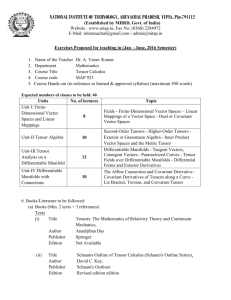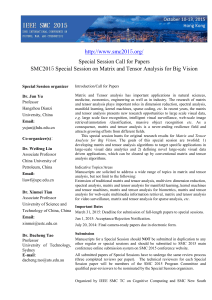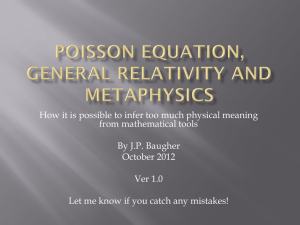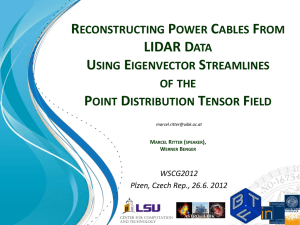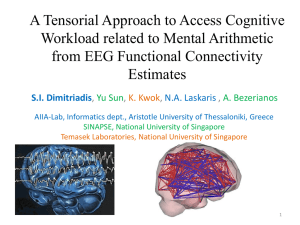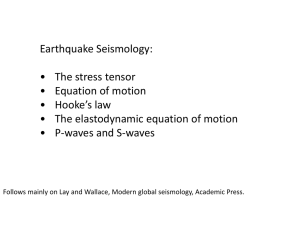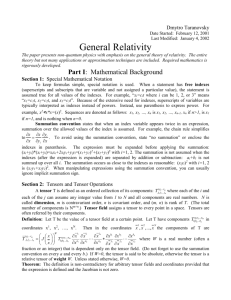Document
advertisement
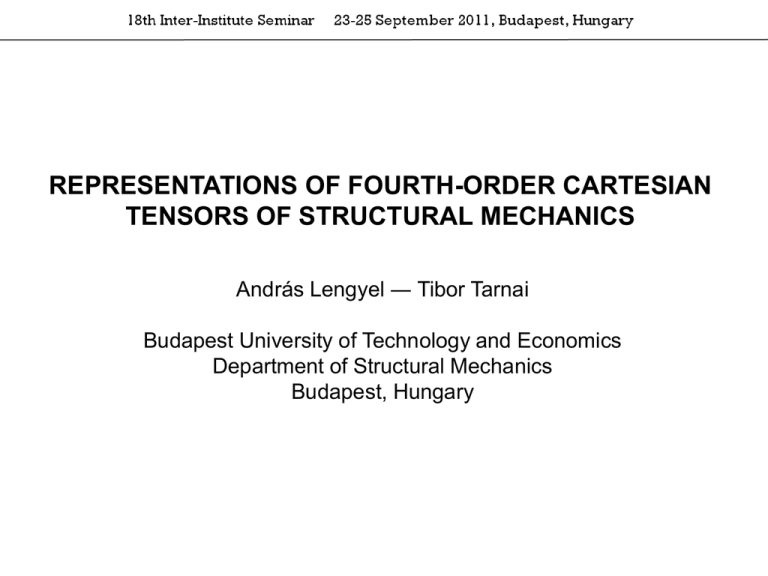
REPRESENTATIONS OF FOURTH-ORDER CARTESIAN TENSORS OF STRUCTURAL MECHANICS András Lengyel ― Tibor Tarnai Budapest University of Technology and Economics Department of Structural Mechanics Budapest, Hungary Tensor: system-independent mapping (Cartesian tensors in the 3-dimensional Euclidean space) Tensor A of order n is an array of entries denoted by Aijk…m with n indices i, j, k, …, m. Hooke’s law: stresses ― strains 4-index notation (tensor notation) Voigt’s notation (matrix notation) ij Cijkl kl ij Sijkl kl σ Cε σ ij Cijkl : ε kl ε ij S ijkl : σ kl 3 3 11 c11 c 22 21 33 c31 23 c41 13 c51 12 c61 3 ij Cijkl kl k 1 l 1 3 ij Sijkl kl C: stiffness tensor S: compliance tensor σ: stress tensor ε: strain tensor k 1 l 1 ε S σ c12 c22 c13 c23 c14 c24 c15 c25 c32 c33 c34 c35 c42 c52 c43 c53 c44 c54 c45 c55 c62 c63 c64 c65 c16 11 c26 22 c36 33 c46 2 23 c56 213 c66 212 C: stiffness matrix S: compliance matrix σ: stress vector ε: strain vector 2 Objectives: • to create representations of fourth-order tensors (e.g. tensors of Hooke’s law) in a way to show their structure, properties, operations, etc. • to clarify technical terms involved in representations (e.g. identity, inverse, definiteness, etc.) 3 Representation: entries of a tensor in an n-dimensional grid vector of lower-order tensors 111 i 112 j 11 12 132 122 13 211 221 113 123 133 212 21 22 222 232 23 311 213 31 32 321 223 312 3 231 i i 2 131 j k 1 121 331 233 322 332 33 313 323 333 4 Representation: entries of a tensor in an n-dimensional grid 1111 k 1211 i 1121 l 1221 vector of lower-order tensors 1112 1231 1122 2121 1331 2221 2112 1232 1123 3111 1132 2131 2231 2331 3221 3131 3122 3331 1322 2321 2212 1332 1223 3123 1323 2213 3212 2313 3312 1333 2223 3113 2323 3322 3213 3313 2333 3332 3233 1313 2312 2322 2113 2332 3222 1213 3311 2233 3232 3133 1113 3321 2123 2133 3132 2222 1312 2311 1233 2232 3231 1222 3112 1133 2132 1212 3211 2122 3121 1321 2311 2211 1131 1311 j 3223 3323 3333 5 Representation: entries of a tensor in an n-dimensional grid 2nd order tensor of 2nd order tensors: matrix of matrices Aijkl (Aij )kl Aijkl 1111 2111 3111 1121 2121 3121 1131 2131 3131 1211 1311 1112 2211 2311 2112 3211 3311 3112 1221 1321 1122 2221 2321 2122 3221 3321 3122 11 21 31 1213 1313 2213 2313 3213 3313 1223 1323 2223 2323 3223 3323 1133 1233 1333 2133 2233 2333 3133 3233 3333 1212 1312 1113 2212 2312 2113 3212 3312 3113 1222 1322 1123 2222 2322 2123 3222 3322 3123 12 22 32 1231 1331 1132 1232 1332 2231 2331 2132 2232 2332 3231 3331 3132 3232 3332 13 23 33 6 Representation: matrix of matrices 2-dot product (double contraction) 3 Cijmn Aijkl : Bklmn 3 3 cijmn aijkl bklmn k 1 l 1 3 c2331 a23kl bkl 31 k 1 l 1 : = 7 Representation: mapping to a 9-by-9 matrix (rearranging 81 entries of the tensor) Aijkl A(ij ),( kl ) Aijkl 1111 1211 1311 2111 2211 2311 3111 3211 3311 ij, kl 11 12 13 21 22 23 31 32 33 F 1 2 3 4 5 6 7 8 9 1112 1113 1121 1122 1123 1131 1132 1133 1212 1213 1221 1222 1223 1231 1232 1233 1312 1313 1321 1322 1323 1331 1332 1333 2112 2113 2121 2122 2123 2131 2132 2133 2212 2213 2221 2222 2223 2231 2232 2233 2312 2313 2321 2322 2323 2331 2332 2333 3112 3113 3121 3122 3123 3131 3132 3133 3212 3213 3221 3222 3223 3231 3232 3233 3312 3313 3321 3322 3323 3331 3332 3333 8 Representation: mapping to a 9-by-9 matrix 2-dot product (double contraction) 3 Cijmn Aijkl : Bklmn 3 3 c2331 a23kl bkl 31 k 1 l 1 3 cijmn aijkl bklmn k 1 l 1 9 c67 a6 mbm7 m 1 : = 9 Representation: quadratic form x x1 ,x2 ,x3 A Aij T 3 Q xT A x 1 3 Q x A x xi Aij x j x1 x1 A11 x1 x2 A12 x1 x3 A13 x2 x1 A21 x2 x2 A22 T i 1 j 1 x2 x3 A23 x3 x1 A31 x3 x2 A32 x3 x3 A33 2nd-order stress tensor: Lamé’s ellipsoid 11 12 13 σ 21 22 23 31 32 33 3 3 Q x σ x xi ij x j x1 x111 2 x1 x212 2 x1 x313 x2 x2 22 2 x2 x3 23 x3 x3 33 1 T i 1 j 1 10 Representation: quartic form 4th-order stiffness/compliance tensor: quartic surface xi x1 ,x2 ,x3 X ij xi x j 3 3 3 3 Q Xij : Aijkl : Xkl xi x j Aijkl xk xl i 1 j 1 k 1 l 1 x1 x1 x1 x1 A1111 x1 x1 x1 x2 A1112 x1 x1 x1 x3 A1113 x1x1x2 x1 A1121 x3 x3 x3 x3 A3333 Q Xij : Aijkl : Xkl 1 11 Representation: quartic form corundum (Al2O3) c11 497 ,5 GPa c12 162 , 7 GPa c13 115,5 GPa c14 22 ,5 GPa c33 503,3GPa c44 147 , 4 GPa GLADDEN J.R., MAYNARD J.D., SO H., SAXE P., LE PAGE Y., Reconciliation of ab initio theory and experimental elastic properties of Al2O3. Appl. Phys. Lett. Vol. 85, 2004, pp. 392-394. Q 497,5 x14 497,5 x24 501 x34 90 x23 x3 995 x12 x22 820,6 x12 x32 820,6 x22 x32 270 x12 x2 x3 1 12 Representation: quartic form Plane of symmetry Crystal n-fold rotational symmetry around axis system x y z x y z triclinic – – – – – – monoclinic – + – – 2 – orthorombic + + + 2 2 2 hexagonal + + + 2 2 ∞ trigonal + – – 2 – 3 tetragonal + + + 2 2 4 cubic + + + 4 4 4 isotropic + + + ∞ ∞ ∞ 13 Tensorial notation 3 3 3 3 Aijkl ? mapping to 9×9 definiteness Matrix representation Aij 99 identity ? inverse eliminating redundancies Voigt’s notation Aij 6 6 14 4th-order tensor – definiteness operation: 2-dot product (double contraction) general tensor (81 elements): A is positive definite if the quadratic form is positive for all nonzero X: Q Xij : Aijkl : Xkl 0 Hooke tensors (21 elements): Stiffness tensor C is positive definite if the quadratic form is positive for all nonzero X, where X is symmetric (or not?): Q Xij : Aijkl : Xkl 0 xi x1 ,x2 ,x3 , Xij xi x j Q ij : Cijkl : kl 0 15 Tensorial notation positive definite 3 3 3 3 Aijkl All crystal groups mapping to 9×9 All crystal groups Matrix representation Aij 99 definiteness positive semidefinite (3 zero eigenvalues) eliminating redundancies Voigt’s notation Aij 6 6 All crystal groups positive definite 16 4th-order tensor – identity tensor operation: 2-dot product (double contraction) I:A A:I A I eijkl ik jl ei e j ek el low symmetry I T eijkl il jk ei e j ek el low symmetry ijkl ijkl IS 1 I IT 2 high symmetry general tensor (81 elements) I, IT, IS ? Hooke tensors (21 elements) I, IT, IS ? aijkl aklij a jikl aijlk 17 Symmetry all permutation of ijkl aijkl aklij a jikl aijlk aijkl a jikl aijlk a jilk aijkl a jilk aijkl aklij aijkl a jikl aijkl aijlk none Different types of symmetry Correspondence to symmetry types Type 15 21 36 45a 45b 54a 54b 81 A15 A 21 N max Type 15 15 21 21 36 36 45 45a 45 45b 54 54a 54 54b 81 81 A36 A 45 a A 45b A54 a A54b I I T IS 18 4th-order tensor – identity tensor operation: 2-dot product (double contraction) I:A A:I A I eijkl ik jl ei e j ek el ijkl I T eijkl il jk ei e j ek el ijkl IS 1 I IT 2 Hooke tensors (21 elements) general tensor (81 elements) 15 21 36 45a 45b 54a 54b 81 I × × × × × × × × IT × × × × × IS × × × 19 Tensorial notation Hooke tensors: I, IT, IS 3 3 3 3 Aijkl general tensor: I mapping to 9×9 Matrix representation Aij 99 identity identity matrix 9×9 eliminating redundancies Voigt’s notation Aij identity matrix 6×6 6 6 20 4th-order tensor – inverse tensor operation: 2-dot product (double contraction) B A1 B:A A:B I inhomogeneous linear equation system 162 equations (81+81, left+right inverse) 81 unknowns (81 elements of the inverse tensor) 15 21 36 45a 45b 54a 54b 81 I × × × IT IS ! ! ! general tensor (81 elements) I unique solution! Hooke tensors (21 elements) I no solution! aijkl aklij a jikl aijlk IS rank deficiency 9 multiparameter solution no inverse! 21 Tensorial notation Hooke tensors: IS (multiple) 3 3 3 3 Aijkl general tensor: I (unique) mapping to 9×9 Matrix representation Aij 99 inverse rank 6 no inverse matrix 9×9 eliminating redundancies Voigt’s notation Aij inverse matrix 6×6 6 6 22 Stiffness and compliance tensors of Hooke’s law – inverse tensor Mathematical problem statement on the inverse tensor Physical problem statement on the inverse tensor inhomogeneous equation system in 81 variables solution sought in 81D space multiple solution! no inverse! mathematical problem statement + conditions applied by physical properties solution sought in 21D space unique solution! 23 Conclusions: • there are a few ways to represent fourth-order tensors (advantages and disadvantages) • concepts of inverse, definiteness, etc. should be handled carefully (mathematical vs. physical, 4-index vs. Voigt’s notation) 24 Thank you for your attention! Our research was supported by OTKA grant K81146 25
